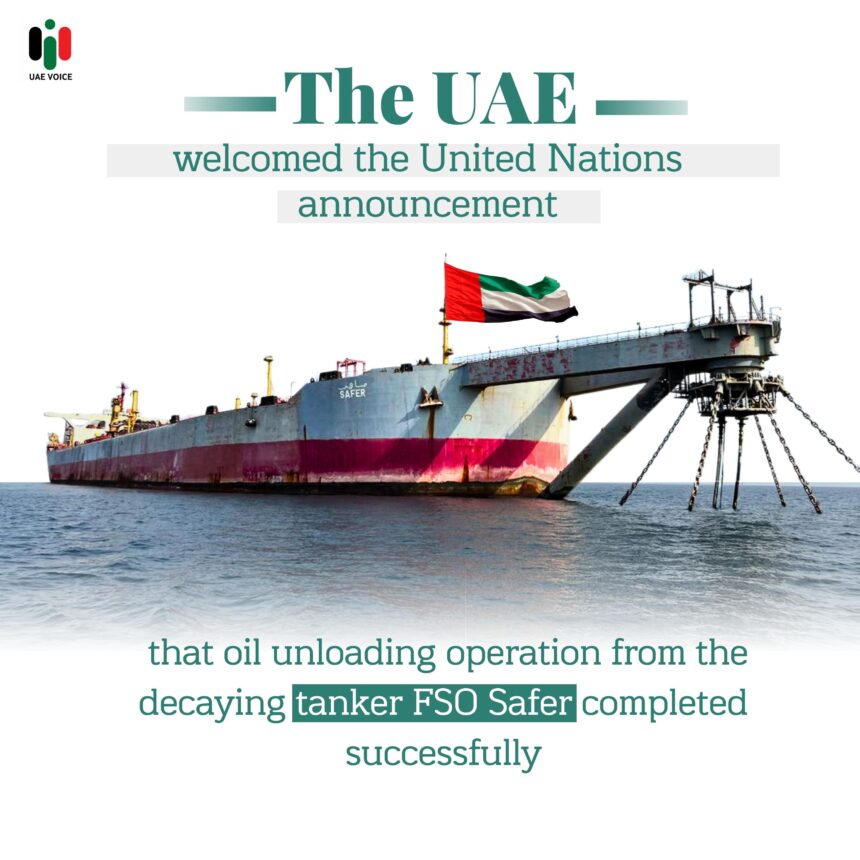FSO Safer Oil Unloading Operation Completed Successfully.
After more than 2 years of political work to collect financial needs and projects development.
The UAE welcomed the United Nations’ announcement that oil unloading operation from the decaying tanker FSO Safer completed successfully.
FSO Safer (pronounced “saffer” /ˈsæfər/)[1] is a floating oil storage and offloading vessel that is moored in the Red Sea north of the Yemeni city of Al Hudaydah.
Prior oil unloading, the ship held more than 1.14 million barrels of oil.
Its structure has been left exposed to humidity and corrosion.
With little or no maintenance since Yemen’s civil war started in 2015.
An impasse exists between Houthi groups and the Saudi-backed government over its ownership and responsibility.
Inert gas on the ship that normally inhibits an explosion has dissipated, putting it at risk of exploding and causing an environmental disaster.
The ship is currently undergoing a United Nations-led salvage operation which has successfully removed the oil and aims to place it in much safer long-term storage.
Safer Story:
Safer moored about 7 kilometres (4.3 mi) off the coast of Yemen in 1988 under the ownership of the Yemeni government via the national oil company.
Moreover, the Yemeni government usedit to store and export oil from inland oil fields around Ma’rib.
In the early days of the Yemeni Civil War, Safer fell into the hands of Houthi forces when they took control of the coastline surrounding her mooring.
In the following years, Safer structural condition deteriorated significantly.
Which led to the risk of a catastrophic hull breach or explosion of oil vapors typically suppressed by inert gas generated on board.
Moreover, the ship contains about 1.14 million barrels of oil valued at up to US$80 million.
Which became a point of contention in negotiations between the Houthi rebels and Yemeni government.
In early December 2019, Al Jazeera reported that oil had begun to leak from Safer.
Though subsequent satellite imagery showed that the report had been inaccurate and there was no sign of oil outflow from the ship.
Following a leak in the cooling system, water entered the machine room.
United Nations Security Council held a special meeting about Safer leaking in July 2020.
On 15 July 2020, the United Nations warned that the FSO Safer could spill four times as much oil as the Exxon Valdez oil spill.
On 24 September 2020, Saudi Arabia‘s ambassador to the United Nations wrote in a letter that experts had observed the following:
“They suspect that a pipeline attached to the vessel has been separated from the stabilizers holding it to the bottom and is now floating on the surface of the sea.”
In late November, the United Nations and Houthi leadership reached an agreement to allow a UN-led team access to Safer by January 2021.
Indefinitely the expedition delayed since the Houthis failed to provide a letter assuring the safety of the UN-led team.
As of October 2021, reports said that the FSO Safer was at imminent risk of sinking, fire or explosion.
-A massive spill would be disastrous.
-Closing the ports of Hudaydah and As-Salif for weeks.
-Disrupting the food aid on which half the population of the country depends.
This could also cause a lack of fuel, necessary for pumping or delivering water.
And could disrupt desalination plants in the area.
Moreover, a spill would shut down the fishing industry on which 1.7 million people depend.
Also it could disrupt world trade passing through the Red Sea and the Suez Canal.
The potential estimated cost of damage was $20 billion.
On 5 March 2022, al-Houthi signed an agreement with the UN to move oil from the tanker and prevent a natural disaster.
The estimated cost of the salvage operation was $80–144 million.
A conference held on 10 May 2022 in the Netherlands raised less than $40 million.
The UN launched a crowdfunding campaign, asking members of the public for contributions as well.
In September 2022, the UN declared that it had raised sufficient money to carry out the first operation phase.
and the UN is looking to countries to provide the funds they pledged.
In March 2023, a statement from Achim Steiner announced that the United Nations Development Programme (UNDP) had purchased Safer.
Along with a tanker undergoing refit in China to begin the first phase of the operation.
In fact, the operation costs approx. US$129 million, only US$75 million of them received, and US$20 million pledged further .
In April 2023 the very large crude carrier Nautica left China to eventually store all oil offloaded from the Safer.
In May 2023, a United Nations operation was initiated to extract 1.1 million barrels of oil.
After that, a specialized salvage vessel, crewed by a team of experts, successfully reached the FSO Safer.
On 12 June 2023, the UNDP announced that it had successfully obtained insurance coverage for the salvage operation.
Which was necessary in order for it to proceed.
A month later, on 15 July 2023, the Netherlands’ Ministry of Foreign Affairs announced the following:
The Dutch salvage company Boskalis/SMIT Salvage had been given the go-ahead to head for the Yemen coast to pump oil from the derelict tanker.
Removal began around 24 July 2023, and concluded on 11 August 2023.
Read More:
Emirati Projects To Support Yemeni People
2023 Yemen Peace Year; Named by the UAE.
UAE Projects in Yemen for Drinking Water (32 Projects).
The UAE supported Yemen with $6.6 billion in aid.





